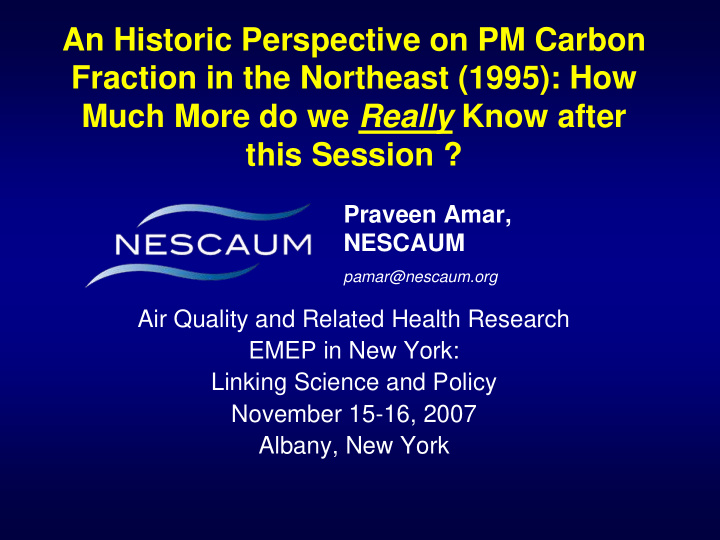



An Historic Perspective on PM Carbon Fraction in the Northeast (1995): How Much More do we Really Know after this Session ? Praveen Amar, NESCAUM pamar@nescaum.org Air Quality and Related Health Research EMEP in New York: Linking Science and Policy November 15-16, 2007 Albany, New York
Five Policy-Relevant Questions from NESCAUM Project • Patterned after the February 2003 NARSTO Assessment, “ PM Science for Policy Makers” • Five questions used to guide NESCAUM’s overall research and assessment effort: – Do carbonaceous aerosols contribute significantly to high levels of ambient PM 2.5 in NY State? – What proportion of carbonaceous PM 2.5 present in NY is derived from in-state sources? – Does carbonaceous PM 2.5 present a public health concern? – What are the technical options for reducing emissions of carbonaceous aerosols from sources ? – What are the near-term strategies for reducing emissions of carbonaceous PM for New York and the region? 2
5
6
7
8
What have we learned today? • Significant exposure to PM2.5 organics in NY City, “Revisit” VOC contribution to SOA; role of biogenics in PM-Carbon fraction in NY City? • Larger Influence of local sources in NYC (commercial cooking using oils, lards, fats, greases); refuse burning, home heating, street vendors in Queens compared to NJ and CT. • Transport scales; local and regional contributions, spatial and temporal (daily, seasonal, annual) gradients in PM2.5 measurements: What do they tell us? EC is local, OC is local and regional (but, unlike sulfate, not “super-regional”?) • Over prediction of EC and POA: need detailed assessment of the EI; need further refinement of PM speciation in source characterization data, beyond OC/EC • Speciation profiles for PM2.5 and VOCs; How good are they? What do they mean ? Do we need to redefine the whole concept? 9
What have we learned today? cont… • POA and SOA: Do we need to redefine the terms themselves? • Direct Emissions: POA: replace the “current static representation of POA emissions with a far more dynamic picture…”; Allen Robinson, et al . ( Science, 2007) • Explicit representation of gas-phase Oxidation of all low-volatility vapors in SOA production mechanisms: how doable? • Sources: Many sources: diesel combustion (on road, off road), wood smoke, motor vehicle exhaust, food cooking, paved road dust, airborne plant fragments, stationary oil and gas combustion, aircraft engines, marine vessels and ports, tire dust, brake dust, cigarette smoke; “markers markers” everywhere ! Integrated approaches using “inverse-grid” models and receptor models sound promising and should improve EIs. 10
What have we learned today? cont… • Human Exposure: wood smoke: “attention must be paid,” rural hotspots: inversions and very local fumigation (not unlike pedestrian tailpipe-exposure); old woodstove fleet has slow turnover rate (like coal-fired power plants, diesel trucks) European Perspective ( Mr. Nussbaumer) this afternoon • • Acute respiratory effects of PM2.5 components (NY City): Over a 3-week period, particles from traffic (BC as an indicator) found to be more relevant indicator of respiratory symptoms than PM2.5; Emergency-room visits over a 2-year period show stronger association with PM2.5 than with BC (“traffic” indicator) • Control options: “Clean” Diesel; “Sustainable” diesel, “Civilized” diesel; DPFs and DOCs, bio diesel; off-road equipment, effect of in-use test cycles 11
12
13
Recommend
More recommend